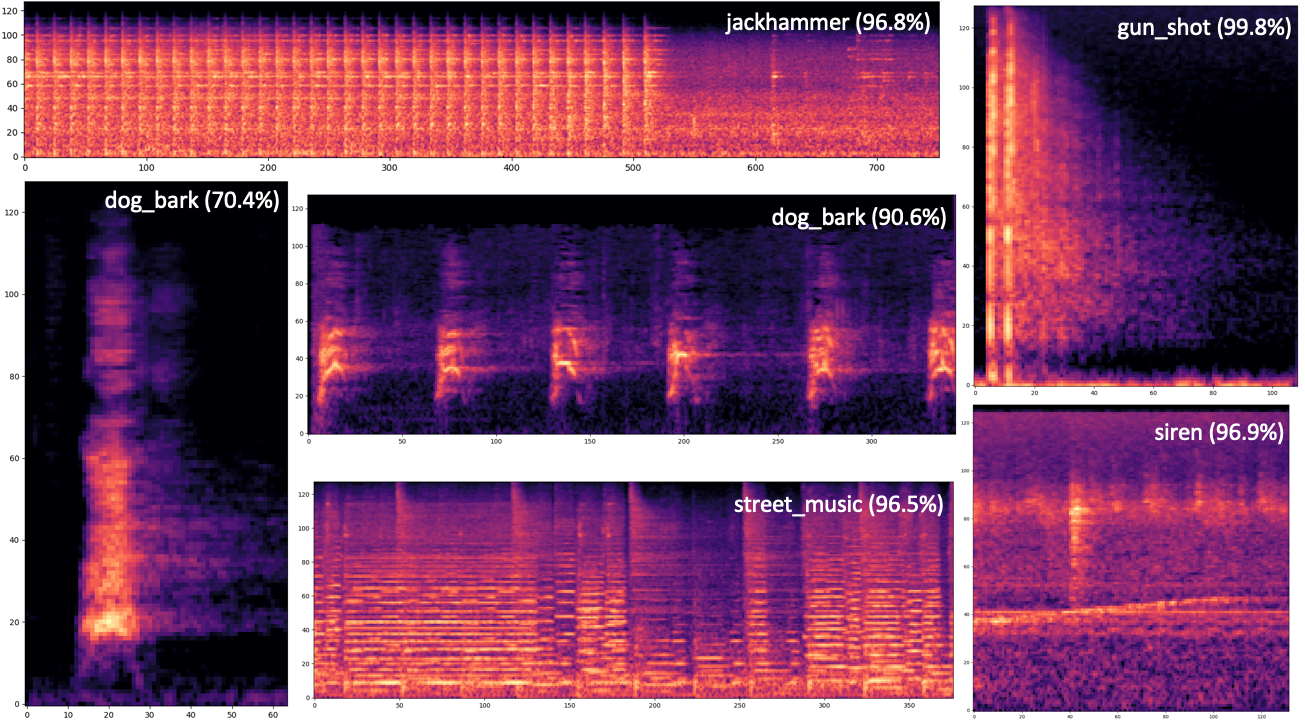Classification of audio with variable length using a CNN + LSTM architecture on the UrbanSound8K dataset.
Example results:
- soundfile: audio loading
- torchparse: .cfg easy model definition
- pytorch/audio: Audio transforms
- Easily define CRNN in .cfg format
- Spectrogram computation on GPU
- Audio data augmentation: Cropping, White Noise, Time Stretching (using phase vocoder on GPU!)
CRNN architecture:
Printing model defined with torchparse:
AudioCRNN(
(spec): MelspectrogramStretch(num_bands=128, fft_len=2048, norm=spec_whiten, stretch_param=[0.4, 0.4])
(net): ModuleDict(
(convs): Sequential(
(conv2d_0): Conv2d(1, 32, kernel_size=(3, 3), stride=(1, 1), padding=[0, 0])
(batchnorm2d_0): BatchNorm2d(32, eps=1e-05, momentum=0.1, affine=True, track_running_stats=True)
(elu_0): ELU(alpha=1.0)
(maxpool2d_0): MaxPool2d(kernel_size=3, stride=3, padding=0, dilation=1, ceil_mode=False)
(dropout_0): Dropout(p=0.1)
(conv2d_1): Conv2d(32, 64, kernel_size=(3, 3), stride=(1, 1), padding=[0, 0])
(batchnorm2d_1): BatchNorm2d(64, eps=1e-05, momentum=0.1, affine=True, track_running_stats=True)
(elu_1): ELU(alpha=1.0)
(maxpool2d_1): MaxPool2d(kernel_size=4, stride=4, padding=0, dilation=1, ceil_mode=False)
(dropout_1): Dropout(p=0.1)
(conv2d_2): Conv2d(64, 64, kernel_size=(3, 3), stride=(1, 1), padding=[0, 0])
(batchnorm2d_2): BatchNorm2d(64, eps=1e-05, momentum=0.1, affine=True, track_running_stats=True)
(elu_2): ELU(alpha=1.0)
(maxpool2d_2): MaxPool2d(kernel_size=4, stride=4, padding=0, dilation=1, ceil_mode=False)
(dropout_2): Dropout(p=0.1)
)
(recur): LSTM(128, 64, num_layers=2)
(dense): Sequential(
(dropout_3): Dropout(p=0.3)
(batchnorm1d_0): BatchNorm1d(64, eps=1e-05, momentum=0.1, affine=True, track_running_stats=True)
(linear_0): Linear(in_features=64, out_features=10, bias=True)
)
)
)
Trainable parameters: 139786
Run inference on an audio file:
./run.py /path/to/audio/file.wav -r path/to/saved/model.pth ./run.py train -c config.json --cfg arch.cfgDataset transforms:
Compose(
ProcessChannels(mode=avg)
AdditiveNoise(prob=0.3, sig=0.001, dist_type=normal)
RandomCropLength(prob=0.4, sig=0.25, dist_type=half)
ToTensorAudio()
)As well as time stretching:
./run.py eval -r /path/to/saved/model.pthThen obtain defined metrics:
100%|█████████████████████████████████████████████████████████████████████████████████████████████████| 34/34 [00:03<00:00, 12.68it/s]
{'avg_precision': '0.725', 'avg_recall': '0.719', 'accuracy': '0.804'}| Arch | Accuracy | AvgPrecision(macro) | AvgRecall(macro) |
|---|---|---|---|
| CNN | 71.0% | 63.4% | 63.5% |
| CRNN | 72.3% | 64.3% | 65.0% |
| CRNN(Bidirectional, Dropout) | 73.5% | 65.5% | 65.8% |
| CRNN(Dropout) | 73.0% | 65.5% | 65.7% |
| CRNN(Bidirectional) | 72.8% | 64.3% | 65.2% |
Per fold metrics CRNN(Bidirectional, Dropout):
| Fold | Accuracy | AvgPrecision(macro) | AvgRecall(macro) |
|---|---|---|---|
| 1 | 73.1% | 65.1% | 66.1% |
| 2 | 80.7% | 69.2% | 68.9% |
| 3 | 62.8% | 57.3% | 57.5% |
| 4 | 73.6% | 65.2% | 64.9% |
| 5 | 78.4% | 70.3% | 71.5% |
| 6 | 73.5% | 65.5% | 65.9% |
| 7 | 74.6% | 67.0% | 66.6% |
| 8 | 66.7% | 62.3% | 61.7% |
| 9 | 71.7% | 60.7% | 62.7% |
| 10 | 79.9% | 72.2% | 71.8% |
- commit jupyter notebook dataset exploration
- Switch overt to using pytorch/audio
- use torchaudio-contrib for STFT transforms
- CRNN entirely defined in .cfg
- Some bug in 'infer'
- Run 10-fold Cross Validation
- Switch over to pytorch/audio since the merge
- Comment things




